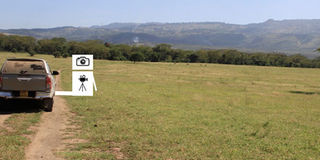Breaking News: At least 10 feared to have drowned in Makueni river
Year WRC began observing event rotation format

The 2020 Safari Rally "Media Zone" before the start of Soysambu Stage. PHOTO | ANWAR SIDI | NATION MEDIA GROUP
What you need to know:
- A wealth of racing knowledge in the sport of rallying, has truly been passed down through racing generations in Kenya? Most notable is the Tundo family, which has been a part and parcel of the Kenya National Rally Championship most importantly in the Nakuru Rally.
- Carl and his sister Tasha simply grew up with the sport, etching the Tundo name into racing history books in the process during last year Guru Nanak Rally when they became the first sister- and- brother crew to win round of the KNRC.
Nineteen-ninety four was first of three years in which an event rotation system in the Safari Rally was applied in the World Rally Championship (WRC) series.
In 1995 the Monte Carlo, Finland and Kenya events qualified for only ‘F2’ series which guaranteed inclusion in the full makes and drives series in 1996 and 1997.
***
In 1995, Hideaki Miyoshi won the Group “N” title on his Safari debut taking fourth overall with a Subaru Impreza run by the Noriyuki Koseki Team after team mates Patrick Njiru and Richard Burns both retired following accidents.
Miyoshi was navigated by Mohamed Verjee. But the finish and Group “N” win counted for nothing as the Safari that year was running a 2-Litre World championship for makes won by the Daewoo Cielo of Azar Anwar.
In 1996, Miyoshi stunned Kenyan hero and team mate Patrick Njiru by overhauling an eight-minute deficit on the last section of the Safari to win the Group N. Miyoshi and Tinu Khan finished 10th the overall and third in Group “N” behind Hamed-Al-Waihibi and Luis Clement.
***
Hats of to former organisers of the Safari Rally when it was considered as the toughest round of the World Rally Championship.
For many of the younger generation, identifying Mike Doughty, Peter Barnes and David Morgan would be difficult but those who remember them, will always give them credit their organisation of the Safari Rally.
Apart from giving detailed news on issues ranging from service schedules, entry lists, driver information, they were able to give spectator guides which are lacking in the present competitions.
The 1993 Safari Service schedule consists of 38 pages of which 30 are of detailed maps.
The information was not just to help the local service crews, but also of great guidance to the spectators and the vast number of foreign crews and journalists.
It had precise information and was released months in advance.
The 1993 Safari Rally, raced over five days, was 3,777 kilometres long with 2,155.90km competitive.
We need to borrow one or two leaves from our predecessors in order to return the event back to its glory days. In comparison, the current Safari Rally is less than 500km long of which about 300km will be competitive. It will be done in three days.
***
Did you know that….
A wealth of racing knowledge in the sport of rallying, has truly been passed down through racing generations in Kenya? Most notable is the Tundo family, which has been a part and parcel of the Kenya National Rally Championship most importantly in the Nakuru Rally.
Carl and his sister Tasha simply grew up with the sport, etching the Tundo name into racing history books in the process during last year Guru Nanak Rally when they became the first sister- and- brother crew to win round of the KNRC.




